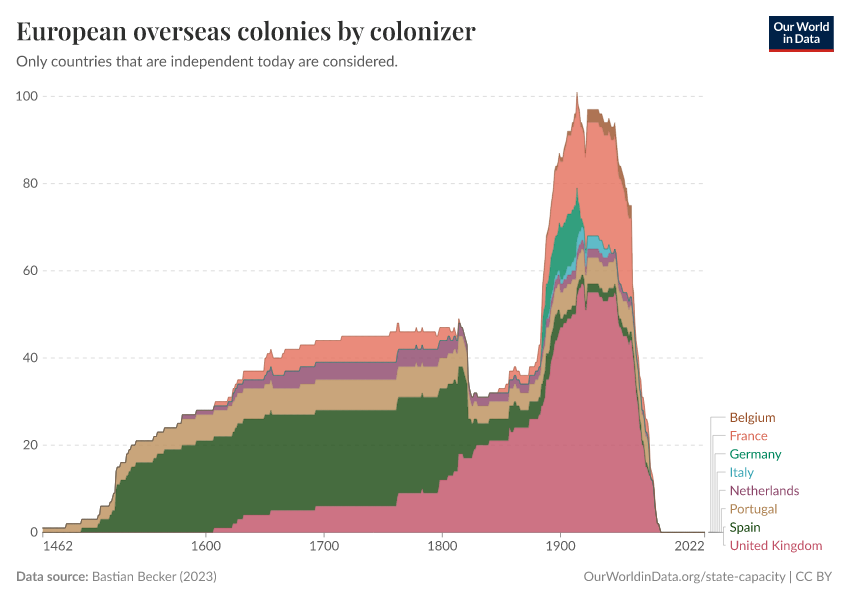European overseas colonies by colonizer

About this data
About this data
Sources and processing
This data is based on the following sources
How we process data at Our World in Data
All data and visualizations on Our World in Data rely on data sourced from one or several original data providers. Preparing this original data involves several processing steps. Depending on the data, this can include standardizing country names and world region definitions, converting units, calculating derived indicators such as per capita measures, as well as adding or adapting metadata such as the name or the description given to an indicator.
At the link below you can find a detailed description of the structure of our data pipeline, including links to all the code used to prepare data across Our World in Data.
Notes on our processing step for this indicator
This is the count of countries each European colonial power colonized each year. Colonized countries or countries not colonized show a null value.
A total for each year is estimated with the country (entity) "World".
Years are defined from last date aggregations available in the Colonial Dates Dataset. This means that when sources differ, years of colonization are defined from the last date between them. This is different from mean date aggregations (also available), which averages the dates of colonization across the original sources.
Years have been expanded to show the full range of years in the dataset, from 1462 to 2022. The original dataset only includes the years where a country was colonized.
Reuse this work
- All data produced by third-party providers and made available by Our World in Data are subject to the license terms from the original providers. Our work would not be possible without the data providers we rely on, so we ask you to always cite them appropriately (see below). This is crucial to allow data providers to continue doing their work, enhancing, maintaining and updating valuable data.
- All data, visualizations, and code produced by Our World in Data are completely open access under the Creative Commons BY license. You have the permission to use, distribute, and reproduce these in any medium, provided the source and authors are credited.
Citations
How to cite this page
To cite this page overall, including any descriptions, FAQs or explanations of the data authored by Our World in Data, please use the following citation:
“Data Page: European overseas colonies by colonizer”, part of the following publication: Bastian Herre and Pablo Arriagada (2023) - “State Capacity”. Data adapted from Bastian Becker, Gapminder. Retrieved from https://archive.ourworldindata.org/20250923-101032/grapher/european-overseas-colonies-by-colonizer.html [online resource] (archived on September 23, 2025).How to cite this data
In-line citationIf you have limited space (e.g. in data visualizations), you can use this abbreviated in-line citation:
Bastian Becker (2023); Gapminder, Population v7 (2022) – with major processing by Our World in DataFull citation
Bastian Becker (2023); Gapminder, Population v7 (2022) – with major processing by Our World in Data. “European overseas colonies by colonizer” [dataset]. Bastian Becker, “Colonial Dates Dataset (COLDAT) 3.0”; Gapminder, “Population v7” [original data]. Retrieved December 22, 2025 from https://archive.ourworldindata.org/20250923-101032/grapher/european-overseas-colonies-by-colonizer.html (archived on September 23, 2025).